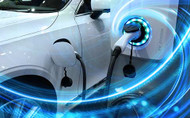Where is Tire Technology Headed?
Oct 14th 2019
Tires may look at a glance pretty much the same as time rolls on—they’re black, they’re round, they’re rubber— but in fact, tires are evolving substantially, especially in their technological features. Over the next decade, as personal vehicles go through perhaps their greatest period of change ever, tire technology will change with them.
Over the past 10 years, the most noticeable tire changes might have been in tread design, rolling resistance, all-weather traction, quieter operation and decreased wear.
Now vehicles are about to change drastically, and so will tires. More vehicles will be electric, and as 2030 approaches, some will begin to be at first partially autonomous, then perhaps completely self-driving. Cars that drive themselves increasingly will be electric-powered.
Electric Onslaught
Tire Review, a trade journal, recently outlined forecasts made in a Smithers Rapra market report, “The Future of Tire Manufacturing to 2024.” The report projects more North American manufacturing in coming years as Asian factories gear up to meet surging demand in that part of the world. U.S. factories will be making new kinds of tires largely to satisfy the demand for electric vehicles.
Make no mistake: Electric vehicles are here to stay—at least until some other technology replaces electricity as the best choice for vehicle propulsion. After selling fewer than 3.3 million electric vehicles in 2019, automakers will sell 26,951,318
electrics by 2030, according to a projection by ResearchAndMarkets.com. That’s an annual growth rate of about 21 percent. Just five model years from now, by 2025, electric vehicles, including battery, plug-in and hybrid electrics, will make up 30 percent of the U.S. market, compared with 1 percent for plug-in hybrids in 2019, according to financial analysts at J.P. Morgan.
Electric-Sparked Tire Changes
As electric propulsion expands, tires will have to change if we are to continue to enjoy longer tire wear. Electrics are heavier than similarly sized gasoline-powered vehicles and have different handling and cornering traits. Right now, according to statistics cited by Tire Review, conventional tires wear 30 percent faster on electric vehicles than on traditional vehicles. That’s expensive to the consumer, so the proliferation of electric cars is bound to force technological changes to promote longer tread life.
Tire Review cites these changes projected by the Smithers Rapra report:
- More tire varieties will be needed to accommodate the different types of EVs and their characteristics.
- Tires will have to wear better for use on EVs, probably by changing footprint shape and contact pressure distribution.
- Rolling resistance will have to diminish further to extend battery life so electric vehicles add range.
- Lighter weight tires will help to counteract the increased weight of EVs.
- Tires will need to run quieter because EVs are quieter.
Autonomous Vehicle-Spurred Changes
The advent of autonomous vehicles is likely to spur these tire technology changes:
- Tires will be taller and thinner to improve aerodynamics and fuel mileage.
- To provide strong performance, improvements in structure and tread will have to make up for narrower contact patches.
- Sensors embedded in tires will better communicate to the vehicle each tire’s position, stress, temperature, wear, and other conditions.
- Ultra-low rolling resistance will improve mileage.
- Noise, vibration, and harshness will have to be better controlled just as for electrics.
Say Goodbye
Some things may disappear:
- Speed ratings. Autonomous cars are expected to have tires that can operate within the performance capabilities and legal limits of the vehicle on which they’re mounted. That’s a big change from the past decade when performance tires took a bigger share of the U.S. market.
- Pneumatic tires. Air pumps will be around for a while, but their need will shrink. General Motors has agreed with Michelin to jointly develop pressure-free tires for highway use. That would signal the biggest revolution of tire technology in tire design since the tubeless tire.
- Chirping tires. We’re talking about an eventual future with no drivers, no performance cars, and maybe no fun, or at least a heck of a lot less of it for people who love driving. When driving becomes automated, old muscle cars will still be around, but what will it cost to insure them?
Anyone interested in a subscription to “Car and Passenger” magazine?
















